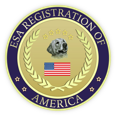Imagine having a letter that not only champions your need for your pet’s companionship but also has the clout to back it up. That’s what an ESA letter does. It’s like a superhero cape for your pet, making them more than just a pet—they’re your support system. But what does this important document actually look like? Stick around as we dive into the nitty-gritty of ESA letters, ensuring you know exactly what to expect and why they’re so key for pet owners needing that extra bit of support.
ESA Letter Basics
ESA letters stand as a key bridge between your need for emotional support and the ability to have your pet by your side in many aspects of life. Authored by a licensed mental health professional, these documents validate your mental or emotional disability and endorse your pet’s role in your support system. Recognizing the nuances in these letters can help you navigate situations requiring proof of your animal’s importance for your wellbeing.
First off, the letterhead matters. Authentic ESA letters come on professional letterhead from a licensed practitioner’s office. This detail lends credibility, ensuring that recipients recognize the document’s legitimacy.
The contents of an ESA letter are equally important. Expect to see a clear statement declaring your need for the emotional support animal, typically without specifying your diagnosis due to privacy concerns. The mental health professional’s license type, number, and the issue date add layers of verification.
Of course, the letter includes the professional’s signature, along with the date it was signed. This detail isn’t just a formality; it’s a requirement that reinforces the document’s validity.
A key point in understanding ESA letters is their expiration. Generally, an ESA letter is valid for one year from the date of issuance. This means you’ll need to renew the document annually to ensure it remains active and accepted in places where your ESA is necessary, such as apartments with no-pet policies.
Note that while ESA letters are powerful, they don’t grant access everywhere. Areas like non-pet friendly restaurants or certain public establishments may still be off-limits. However, they provide a significant advantage in housing and air travel, enabling your emotional support animal to accompany you without extra fees or restrictions.

Key Features of a Legitimate ESA Letter
A genuine ESA letter has certain features you’ll want to look out for to ensure it’s the real deal.
Issuing Authority
Look for the letterhead, which should prominently display the name and contact information of the licensed mental health professional (LMHP) or medical doctor who issued the letter. This includes their license type, number, and the state where it was issued. The presence of this information adds credibility, making it clear that the letter comes from a recognized authority in the field of mental health.
Date of Issuance
An up-to-date letter is key, as ESAs are subject to the current laws and regulations affecting housing and travel. Legitimate ESA letters include the issuance date, and it’s important to note that they typically hold validity for one year from that date. You’ll need to renew the letter annually to maintain its legitimacy.
Patient Information
The letter must clearly identify you as the patient or the recipient of the ESA. This includes your full name and sometimes your address, ensuring there’s no doubt about whom the ESA letter pertains to.
Verification of Disability
One of the letter’s key components is the validation of your need for an ESA as part of your treatment plan. It will state that you have a diagnosed condition recognized by the Diagnostic and Statistical Manual (DSM) of Mental Disorders and that the ESA is necessary for your mental health and well-being.
Animal Description
While not always required, some letters will describe the ESA in question, including the type of animal, to prevent any confusion about who your ESA is. This can be particularly helpful in situations where specific animal types might be restricted.
Professional’s Signature
The cherry on top of a legitimate ESA letter is the LMHP’s or doctor’s hand-signed signature, often accompanied by their professional stamp. A digital signature might be accepted in some cases, but the authenticity of the signature is what seals the letter’s credibility.
Differences Between ESA Letters and Service Animal Certifications
While both serve vital roles in assisting individuals, they’re recognized and regulated differently.
Issuance Authority: ESA letters come from licensed mental health professionals, such as psychiatrists, psychologists, or licensed clinical social workers. In contrast, service animal certifications might be issued by recognized training organizations or by health professionals, depending on the laws governing service animals in your location.
Legal Recognition: Federal laws, including the Fair Housing Act (FHA), acknowledge ESA letters, granting individuals the right to live with their emotional support animals despite pet policies. Service animal certifications, however, are recognized by the Americans with Disabilities Act (ADA), offering broader access rights, including public places, like restaurants and shopping centers.
Purpose and Use: ESA letters primarily support the need for an animal due to emotional or psychological conditions. Service animal certifications validate an animal’s training to perform specific tasks for individuals with physical or mental disabilities.
Animal Type and Training: Emotional support animals don’t require specific training because their presence alone provides comfort. Service animals, specifically dogs and, in some cases, miniature horses, must undergo extensive training to perform tasks directly related to the individual’s disability.
Renewal and Verification: ESA letters may need annual renewal to remain valid. Service animal certifications might not expire but could require re-certification based on the training organization’s guidelines or as needed to reflect the animal’s ability to perform its duties.
Recognizing these differences ensures you’re equipped with the correct documentation, contributing to a smoother process when asserting your rights or making accommodation requests related to your animal companion.
How to Spot a Fake ESA Letter
Identifying a fake ESA letter is vital, especially in the context of distinguishing it from legitimate documentation for your emotional support animal. After understanding the essence and requirements of an ESA letter, spotting a counterfeit becomes less challenging. Look out for several key indicators to ensure you’re holding a genuine document.
Check for a Professional’s Details: A legitimate ESA letter must come from a licensed mental health professional (LMHP). This includes their full name, license number, and contact information. If the letter lacks these essentials or the details cannot be verified through a simple search, it’s likely a fake.
Examine the Letterhead and Signature: Authentic letters are on official letterhead that includes the professional’s contact information. The signature must be hand-signed, not digitally inserted. A lack of these elements points to a fraudulent letter.
Verify the Issue and Expiry Dates: Legitimate ESA letters include an issue date and an expiry date, usually valid for one year. If the letter doesn’t specify these dates, treat it as a red flag.
Scrutinize the Language Used: Official documents use formal language and clearly state your need for an ESA due to a diagnosed condition, without revealing sensitive personal medical details. Overly vague or overly detailed letters might be suspect.
Beware of Instant Approvals: Genuine ESA letters require an evaluation by an LMHP. Instant approval offers, especially those without a proper assessment, are almost certainly scams.
Question the Source: If the letter was obtained from a website offering a quick fix, or requiring little to no interaction with a healthcare provider, it’s likely not valid. Authentic ESA documentation requires a thorough evaluation process.
Acquiring a Legitimate ESA Letter
Getting your hands on a legitimate ESA letter is a key step in ensuring your emotional support animal (ESA) can legally accompany you in many settings. This process involves several important steps to ensure that the letter you obtain is valid and recognized under the law. Here’s how to secure an authentic ESA letter.
First, consult a licensed mental health professional (LMHP). This could be a psychologist, psychiatrist, or licensed clinical social worker, among others. It’s key that the professional has a valid license to practice in your state. During your sessions, they’ll evaluate your need for an ESA as part of your therapy plan.
Next, understand that a legitimate ESA letter must contain specific details. These include the LMHP’s official letterhead, their license number, and the date the letter was issued. The document should explicitly state that you have a mental or emotional disability recognized by the Diagnostic and Statistical Manual of Mental Disorders (DSM) and that your ESA is a key part of your treatment.
Avoid services offering instant approval or requiring no real-time interaction with a therapist. Legitimate ESA letters can’t be obtained instantly or through a generic online questionnaire. Real evaluations take time and involve a genuine therapeutic consultation.
Always verify the credentials of the issuing LMHP. If you obtain your letter online, ensure the platform connects you with a licensed professional capable of legally practicing in your state. Some platforms offer to connect you with suitable professionals for a fee, but always research reviews and check their Better Business Bureau (BBB) rating to avoid scams.
Conclusion
Understanding what ESA letters should look like empowers you to navigate the process with confidence. Remember, the legitimacy of your letter hinges on the credentials of the issuing professional and the specific details it contains. Steer clear of shortcuts and instant approvals that seem too good to be true. By following the steps outlined, you’ll ensure your emotional support animal is rightfully recognized, allowing you both to enjoy the benefits of companionship without unnecessary hurdles.











